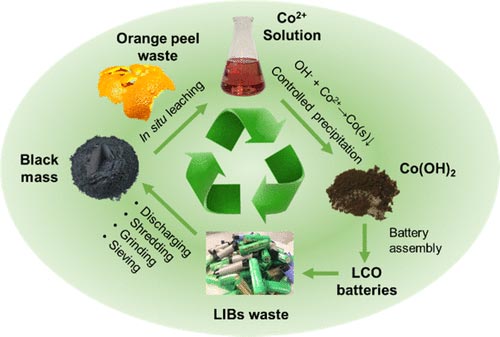Food waste and electronic waste are two aspects of the waste stream that present a multitude of challenges for human society. Now a team of scientists led by the Nanyang Technological University (NTU), Singapore has developed a way to use food waste–specifically orange peels–to recover precious metals from spent lithium-ion batteries for reuse in the creation of new batteries.
‘An estimated 1.3 billion tonnes of food waste and 50 million tonnes of e-waste are generated globally each year.
Spent batteries are conventionally treated with extreme heat (over 500°C) to smelt valuable metals, which emits hazardous toxic gases. Alternative approaches that use strong acid solutions or weaker acid solutions with hydrogen peroxide to extract the metals are being explored, but they still produce secondary pollutants that pose health and safety risks, or rely on hydrogen peroxide which is hazardous and unstable.
Professor Madhavi Srinivasan, co-director of the NTU Singapore-CEA Alliance for Research in Circular Economy (NTU SCARCE) lab, said: “Current industrial recycling processes of e-waste are energy-intensive and emit harmful pollutants and liquid waste, pointing to an urgent need for eco-friendly methods as the amount of e-waste grows. Our team has demonstrated that it is possible to do so with biodegradable substances.”‘
Current industrial processes for recycling batteries involve shredding the batteries and crushing them into a powdery substance. That powdery substance is either smelted at temperatures above 500 degrees Celsius to separate metals or subjected to a chemical leaching technique using a mixture of acids and hydrogen peroxide plus heat. The newly developed process substitutes orange peels instead of the acids and hydrogen peroxide typically used. The researchers oven-dried orange peels, ground them to powder, and mixed them with citric acid, a weak acid found in citrus fruits.
‘Asst Prof Tay explained: “The key lies in the cellulose found in orange peel, which is converted into sugars under heat during the extraction process. These sugars enhance the recovery of metals from battery waste. Naturally-occurring antioxidants found in orange peel, such as flavonoids and phenolic acids, could have contributed to this enhancement as well.”
Importantly, solid residues generated from this process were found to be non-toxic, suggesting that this method is environmentally sound, he added.’
The researchers were further able to use metals recovered via this process to assemble new lithium-ion batteries which displayed a charge-capacity similar to commercially available batteries. The team is hoping to further optimize the batteries they can produce in this fashion and extend their “waste-to-resource” approach to other cellulose-rich fruit and vegetable waste and other lithium-ion battery types.
Learn more:
“Repurposing of Fruit Peel Waste as a Green Reductant for Recycling of Spent Lithium-Ion Batteries” by Zhuoran Wu, Tanto Soh, Jun Jie Chan, Shize Meng, Daniel Meyer, Madhavi Srinivasan and Chor Yong Tay, 9 July 2020, Environmental Science & Technology.
DOI: 10.1021/acs.est.0c02873

